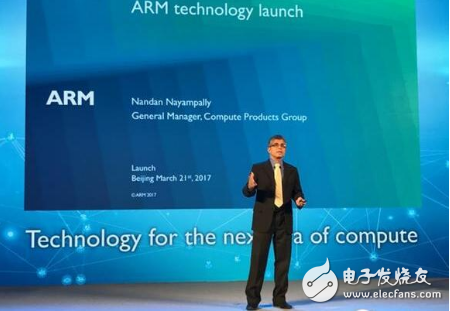One of the most surprising is that Nandan Nayampally, vice president of ARM and general manager of the Computing Products Division, claimed that according to ARM estimates, ARM's next-generation chips carrying DynamIQ around 2020 will have a 50-fold performance improvement over the current artificial intelligence performance. .

Nandan Nayampally, Vice President of ARM and General Manager of Computing Products Division
Fabless model helps ARM to complete 100 billion chip shipments in 27 years
With the fiery smartphones in recent years, ARM's three letters have become known to the general public. But what most people didn't know was that ARM's predecessor, Acorn, was officially established in 1978 by physicist Hermann Hauser and engineer Chris Curry in London, England. In 1990 ARM broke away from Acorn and opened his own legendary road. With the rapid development of mobile phones in the 1990s, shipments of chips based on ARM technology reached a total of one billion tablets in 2002, and in the following 15 years, it is more like opening and closing. In 2005, shipments of one billion units were completed. In 2010, the shipment rate of one billion tablets was shortened to one quarter. By 2013, the time was further shortened to only one month. In 2017, it officially announced that it had reached a milestone in the shipment of 100 billion chips, and achieved brilliant results. Behind this, Fabless this unique mode of authorization contributed, but what exactly is Fabless?
In the semiconductor chip industry, the company's model is mainly divided into three types, one is from the design, manufacturing, packaging, testing and investment in the consumer market, all-inclusive companies, known as IDM (Integrated Design and Manufacture) companies, such as we know Intel. The advantage of the IDM model is that since all links are all packaged, the time from IC design to completion of IC manufacturing is shorter and there is no problem of process interconnection. The disadvantages are also obvious. That is, the demand for funds is enormous. TSMC will use a new 18-inch fab as an example, with a budget of US$15.9 billion. This is obviously not something that semiconductor manufacturers can afford.
When it comes to Fabless, we have to mention Foundry. Fabless only does design and not production. The representative company is ARM. ARM does not manufacture or sell any chips. It only designs its own IP, including instruction set architecture, microprocessors, graphics cores, and interconnect architectures. Then whoever wants to sell the licenses to anyone who wants to. As for customers who want to get ARM's IP, they don't want to do anything.
Foundry (Taiwan) representative companies TSMC and Global Foundry are only doing OEM and do not design. The advantages of Fabless are its flexible design and low design cost. The downside is that it needs to cooperate with the foundries. For example, after you design a 10nm chip, you can only worry if the foundry process is not reached. However, traditional semiconductor giants such as Intel did not pay much attention to the mobile market in the past, making no competing ARM companies develop rapidly. It is their unique licensing model that really pushes them to the top.
ML and AI instruction sets help DynamIQ dominate the artificial intelligence market
Intelligent artificial voice application scenarios such as intelligent voice, image recognition, autopilot, drones, and personal assistants are not unfamiliar to everyone. However, at the just-concluded two sessions, artificial intelligence was first written into the government report and it can be seen that the current artificial intelligence is important. Sex. There are two important factors that artificial intelligence can achieve: computing power and algorithms. At this DynamIQ conference, Nandan Nayampally deliberately used a long space to introduce DynamIQ's many features. I believe this is also the deep meaning of IQ with the last two letters of the DynamIQ word.
ARM believes that accelerating artificial intelligence and machine learning should be achieved by improving the performance of both CPU and system-on-chip. The instruction set is the soul of the processor. Although the traditional ARM chip has been used in the field of artificial intelligence, due to the lack of native instruction sets, the current ARM chips are not very efficient in machine learning or artificial intelligence. To this end, ARM has developed native ML (machine learning) and AI (artificial intelligence) instruction sets and added them to DynamIQ to enhance the performance of the chip in the field of artificial intelligence. According to ARM's own calculations, the next 3 to 5 years Internally, with DynamIQ's dedicated processor instructions and optimized library architecture, the performance of artificial intelligence computing will be increased by 50 times. This will also be the basis of the future Cortex-A 8 series processors, allowing ARM's public architecture to compete with other third-party architectures.
Safety first
With the advent of the Internet of Things, security issues have become increasingly serious. In ARM's view, there are three main areas for improving security: high performance, fast response, and rapid failure recovery. Taking the automotive industry as an example, the number of electronic control units used in a high-end luxury car today is as high as tens of thousands. At present, a large number of cars use ARM chips, and the stability and safety of the chips are closely related to all passengers in the car. Security. This release of DynamIQ technology specifically introduces solutions for ADAS (Advanced Driver Assistance Systems) to improve overall safety and reliability, and to ensure that partners can design ASIL-D compliance systems that can operate safely even in the event of a fault. .
1 2 Next>Aquarium Equipment,Aquarium Air Pump,Submersible Pump,Intelligent Aquarium Lamp
Sensen Group Co., Ltd.  , https://www.sunsunaquariums.com